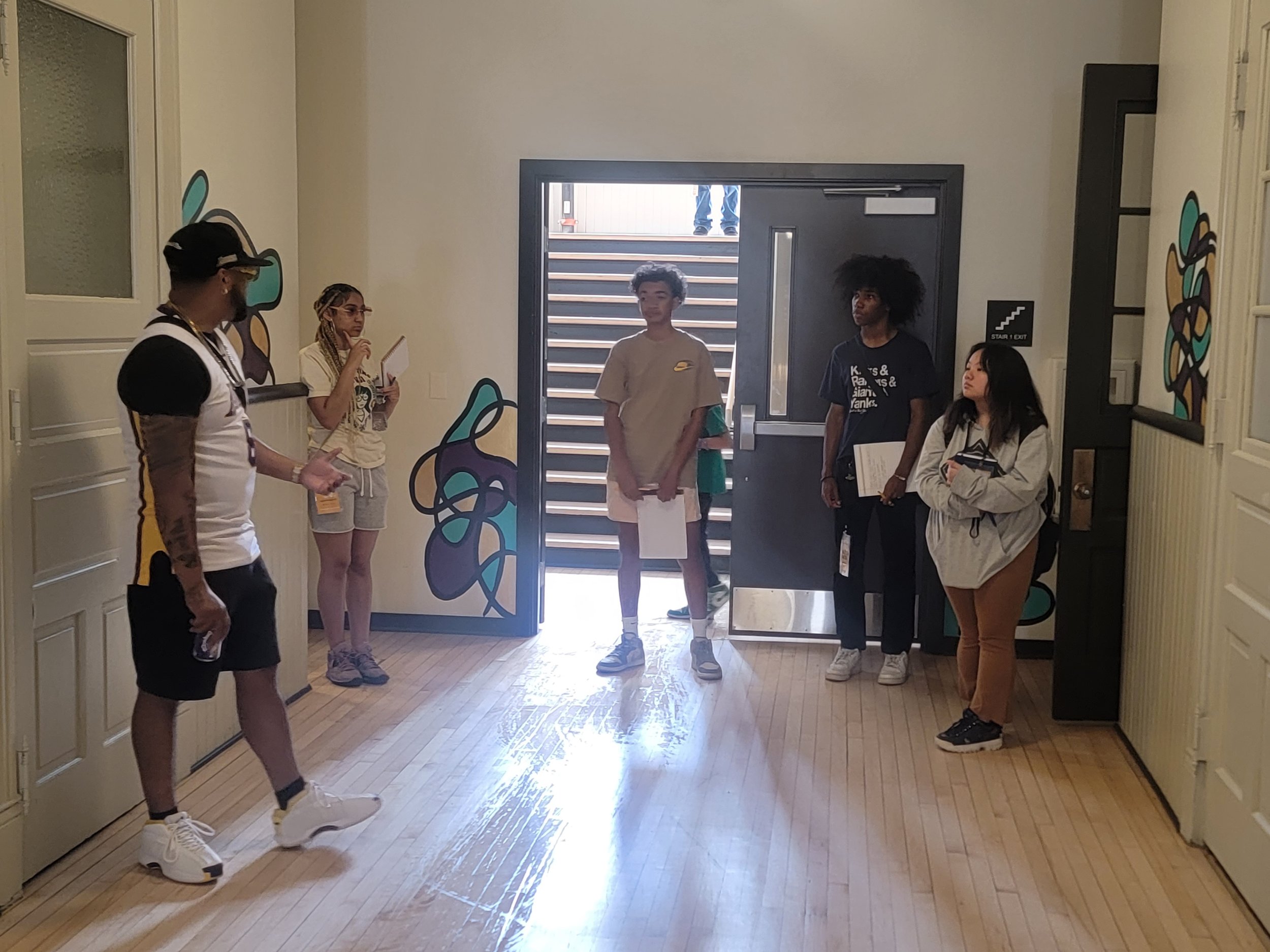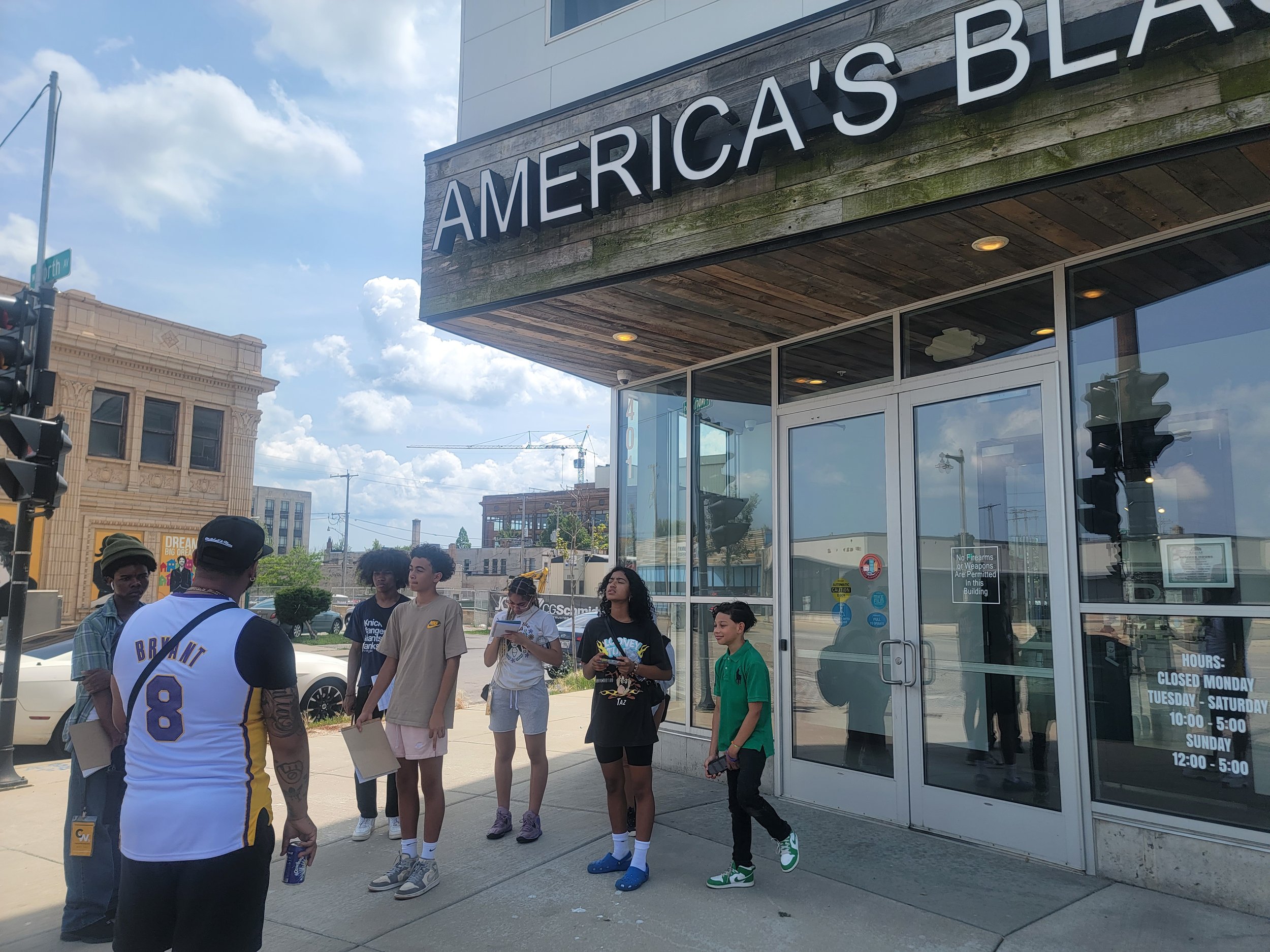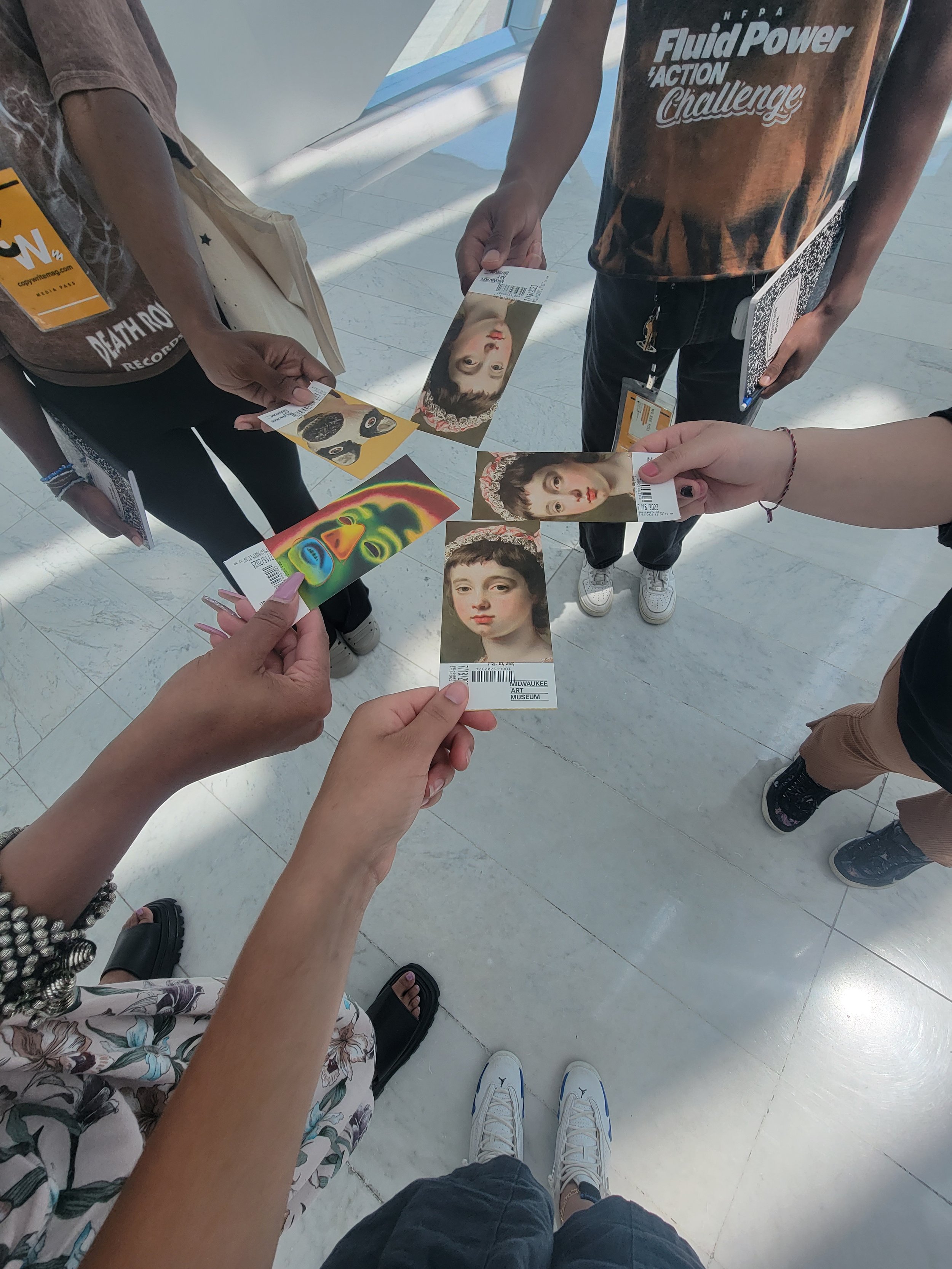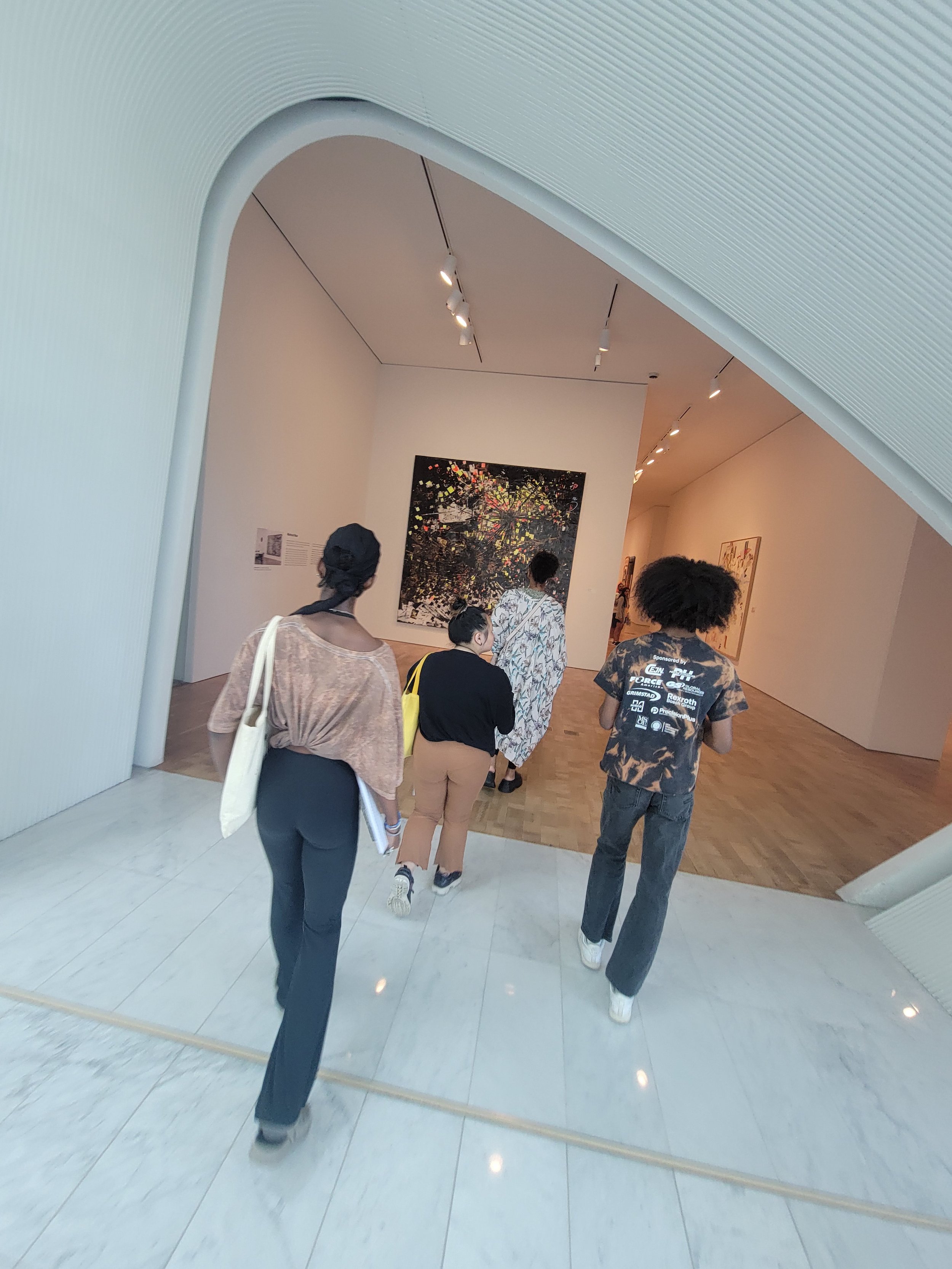Juxtaposing perspecetives | An In The Field Reflection from /CW Summer 2023 Youth Interns
/As many know, this summer CopyWrite Magazine with our partners Jazale’s Art Studio, hosted four Summer Youth Interns. Aligned with the authentic nature of both organizations' creative practices, we found it fitting to immerse our interns in “In the field” research that showed them the juxtaposing nature of our creative community. With a guided tour of the Bronzeville neighborhood and the Milwaukee Art Museum, each intern noted their perspectives of community, culture, and space. They wrote their perspectives in the format that best served them, also showing that communication varies depending on how you view the world. [Its the agency in methodology for us]. It should be a reminder to us all that archiving perspectives brings light to future questions. What are WE saying to the next generation and what will they say about us?
Cameron Barker | Reflection
Bronzeville
Walking through Bronzeville introduced me to a new perspective on art that is used when investigating what art is and who it is for. The installations in the Historic Garfield Apartments allow for people who typically can’t go to museums and displays to interact with and view art, and the style of art used allows for it to add to the space subtly without being overpowering. In addition, the preservation of the artwork done by the kids who went to the school before it was transformed, shines a light on the real history of buildings in the local environment. By preserving the artwork, it gives importance to the artists. Every kid that worked on that piece is at a much later stage in their life now, and for them to be able to look back at what they did and see that it was preserved also gives their past value, and further shows them the importance of having experiences like that in their childhood.
The development being done in the Bronzeville area is another thing that interested me on our walk. The initiative to build a high school for minority students in this community is an important push to further strengthen it and give kids better access to quality education, while also counteracting gentrification in the area. As these development projects become completed their is a high probability to displace people who already live in this area. If property taxes rise, and people simply can’t afford to live in the same place as they used to, then they’ll be forced out and people with more money than them will move in, renovate, and paint over the vital history of this area. Fortunately for the present residents, the people who want to come in and gentrify the area may be put off by the proximity to a high-school for minority students, which in itself is an interesting dynamic. Why do the people with the money to support and engage in development not want to be close to certain demographics? They’ll support from afar, but when they have to go to the communities and interact with the people who live in them, they are hesitant or unwilling.
Going to the Bronzeville Collective shows me the work that people in the community are putting in to maintain and support local entities. The store had a variety of products including candles, apparel, jewelry, and self-care products all of which are made by black, brown, and queer producers. Knowing that the money that I spent is going to someone who looks like me or lives in the same community as me, builds a stronger relationship between me as a consumer, and the designer or producer. Money isn’t everything, but one thing money is for certain is power. Money is the power to support a family, the power to protect a family, and the power, if in the wrong hands, can move families. The importance of knowing where money goes is so significant especially when supporting local businesses, because it’s much more likely that the money they receive goes directly back to the communities they are a part of. Local businesses bring money into communities and the money they bring in flows in a cycle throughout the community, strengthening it and moving it forward.
Milwaukee Art Museum
The Milwaukee Art Museum differs vastly in the way they display and interact with art when compared to people in the Bronzeville area, and the dynamic between the two paints a polarizing picture of how each entity perceives each other. The people who purchase and display art in museums base the worth of art on not only its visual appearance but also the context it was created in. They believe that beyond the surface, art can convey messages through the artists’ perspective, but also by analyzing what was happening during the time the art was being created. If an artist were to paint a beautiful flower during WWII, some appreciators of the art may claim it’s worth more because the content of the painting contrasts with the context of the time. While people who view art at the museum level may think about these intricacies of appreciating art, people in communities such as Bronzeville may not view art in the same light.
The worth of art is completely subjective, and to some, the value of a canvas with paint on it is more than that of a car, a house, or even a private jet. For the people who consume art at such a high level, the price of a piece in their eyes is completely justified, no matter the amount. On the other end of the spectrum, people who don’t go to the museum at all, and don’t care for art simply cannot see the value in the things that others would say are valuable. To them, ‘Summer Sentinel” by Anne Truitt is nothing more than two blue blocks put on top of one another, with their only value being in the material the artist used to make them. To not see the deeper meaning, if any, of the artwork is not the fault of the viewer. If the artist intended to convey a message, in some way shape, or form, then it must be able to be received by the ones who look upon their work.
The disconnect then is created when the people who believe they see the deeper meaning, and believe that they understand what the artist is trying to convey also believe that people who cannot see what they see are “below” them in some way. They blame the inability of others to perceive the value of art on their economic status, their education, or the color of their skin. In opposition, the people who do not care for artwork ridicule those who appreciate it, calling them delusional, only making up meaning for art so they can buy and sell it for a higher price. When money plays such a big role in determining how art is consumed and viewed, it becomes hard for each side to see where one other is coming from. Why should someone spend any amount of money to view art, when they can simply spend that money on anything else? And why should people try to show art to those who don’t go to museums, if they don’t understand it? Of course, generalizing doesn’t do either side any justice. Some people are more fortunate and do not place much value on art, and some people are less fortunate and greatly appreciate art. To break down these negative connotations, art should be more accessible to everyone. Sculptures should be in more places, architecture should be more expressive, and spaces should be designed with an artistic mindset.
Art is everywhere, but not always uncovered.
Nahsialis Vang | Reflection
Bronzeville
On Friday July 14th, we toured around the Bronzeville community. Looking around the area, you can tell that it is not well-established physically. Trash on the ground indicates littering and heavy on historical buildings, it becomes aware that it looks a little rusted. But through the exterior aspects of Bronzeville, we also got to experience the internal aspects of Bronzeville, art and community courtesy of Lexi and Vedale.
In the building shown as 18 Public Schools [now the Historic Garfield Apartments] within the Bronzeville community, it is actually filled with residents who live in the building. As we got to go inside the building, we explored the aspects of what makes the building. Externally, it is a historical building that was built in 1887 but the interior, it looks rather modernized even if the scent was similar to older wood and rustic metal.
As we got to explore more of the building, we got to learn more about the history and aspects of what makes it a community. The building was previously used for a school which you can tell by the layout of it. Going on the top of the building, you can see the artwork that was painted from a class in the 1990s that was restored in an area where locals can intermingle with one another in a gym turned community room. It is important to understand the community as “people who help salvage and curate it are just as important” (Lexi).
Art Museum
Establishment and community is just one of the many things that set apart the Milwaukee Art Museum and Bronzeville. This may also include the type of art that is in each place, the cost, which includes both the pieces and the admission fee, along with simply the “feel”. Understanding that there is a difference is simply the first step to realizing, the audience is targeted differently.
When first walking into the Art Museum, there you can tell the establishment is well put together and relatively neat. Before actually entering into the art museum, water was forbidden as it could potentially be a hazard to the artwork that was in there. This specific establishment was designed for us to continuously walk around and just indulge in the many art pieces that are within. It is not relatively loud so you can hear the footsteps everyone takes while roaming.
With each footstep and pivot you take, you can see the different artworks that would not necessarily be in a place like Bronzeville, or connecting a community and showcasing what community is. Just looking at who owns a collection, you can tell the expensive taste that is homed into the Milwaukee Art Museum. With a simple name like the Bradley Collection, you can tell how expensive it is as the many known places like the Bradley Center and the Bradley Foundation are linked to that family. Noting expenses, a simple portrait of a woman “was acquired for about $3.5 million, according to museum sources” (Schumacher). The piece is called Alice Hooper by John Singleton Copely which was created in 1763.
Although there are many differences between these two places, one thing in common is simply, art. Finding art anywhere allows the “little C culture” (Lexi) to be showcased anywhere. It allows the ideas of art to be intersectional, interracial, and international which allows all people to be inspired by what they see. Art is everywhere and can inspire audience.
Works Cited:
MAM makes largest acquisition in its history by Mary Louise Schumacher of the Journal Sentinel - September 12, 2011
https://archive.jsonline.com/blogs/entertainment/129672823.html
Frederick Calhoun | Reflection
When touring the Bronzeville neighborhood and the Milwaukee Art Museum, I noticed different things throughout each. Bronzeville was more of a “hood” beauty, while being at MAM was more on what I think a white resident would want to experience. Even with that said, I learned about finding beauty in different spaces.
Now, I’ve always found the “hood” to be perfect in many ways ; but every time I see something being built up from nothing. It makes me happy to be situated and living.
Bronzeville is an area in Milwaukee that is usually looked over when tourists visit. It has hidden beauty throughout it. The corner stores, the beauty supply stores, and the Black owned businesses bring joy to my face as I noted down each one on our walk. The development in the area seems to be focused on Black identity too. This includes America's Black Holocaust Museum’ and The Bronzeville Collective, along with a collection of academic placements being built. Creativity is often overlooked here, because of the location, but I feel as though a lot of people should take their time and find beauty! Now, I’ve always found the “hood” to be perfect in many ways; but as I see so many things being built up from nothing here, it makes me happy to be living in this time off growth and change.
The Milwaukee Art Museum area [by the lake] was great, but it made me feel a bit loose being inside the space. It was more of a white space [physically & racially] than anything. To be completely honest; there were limited art pieces by people of color or Black people in general. Some of the work that stood out for me discussed the hardship of the Black experience and not the joy [which was already a strike for me]. However, the Derrick Adams exhibit, Our Time Together, did show the essence of Black joy rooted in community, people, and neghboor-“hoods”, just like Bronzeville.
So to compare Bronzeville to the Milwaukee Art Museum there's absolutely one that is more enticing to me. Being more open to Black culture, seeing a lot of people “doing their big one” by focusing on enhancing their careers and wealth, seeing how art lives here without pre determined boundaries, Bronzeville is more my speed.
Finalizing my thoughts, this was one of the best experiences ever. It of course was not my first time visiting Bronzeville or my favorite spot on the walk, The Bronzeville Collective, but every time I visit it's even more breathtaking. That community & lifestyle just speaks to me!
Jazale Hill | Reflection
Outside Vs. In
You never know what a house looks like until you walk through the door. There are structures I drive or walk past daily and imagine what it might look like inside. Although most don’t think of a home as art or their neighborhood as creative, it is. The way many buildings are placed with grass in front, the side, the color, the shape, it is all art. It took creativity for someone to build your neighborhood, giving many a sight to see instead of just looking at cars driving, garbage on the roads, or civilians walking. A house is not just a HOUSE. IT IS ART.
The house I live in is art, LITERALLY. Vedale Hill, and partners at HomeWorks: Bronzeville plan to expand our neighborhood in Bronzeville. They hope it can be a legacy that changes - the community. 2408 N Vel R Phillips ave, a new legacy. The inside is a beauty but how the house looked 2 years ago when first purchased was not as appealing. Many would not think there's a balcony looking down from a mezzanine to the lower level, or that a huge chandelier is hanging in the middle of the gallery space with edison bulbs all over. This is because this house is not located in a neighborhood many would imagine a luxury house to be in. The Bronzeville area is known for many successful black owned businesses, as well as the poverty surrounding it due to inequitable policies. That is why many, but NOT ENOUGH of localists are planning to redevelop our neighborhood inside and out, while trying to offset the gentrification that is already happening. Meaning, not only will you notice changes physically upon buildings but in people as well, attempting to lower crime rate and stupidity spurring around, helping those in need, and expanding knowledge.
Around the city of Milwaukee there has been construction everywhere! Making it tricky for many to get to point A and B but these new additions and redevelopment in historical buildings such as ThriveOn King which will be located at 2153 N. Dr. Martin Luther King Jr. Drive and the Milwaukee Public Museum soon to be located in the Haymarket neighborhood on 6th and McKinley. Those two and many others are the start of sculpting a new future for many.
2408 N Vel R Phillips Ave, also known as the house on 4th and Meineke, is a Legacy building in my eyes. July 15th, 2023 was a day of celebration because one house got demolished of the three buildings on the property. It is the most expensive show I will ever see [costing $50,000 to demolish due to a faulty foundation], the most genuine show I will ever see, and the most impactful show I will ever see. It was a day of freshness and renewell, because Vedale Hill, my father, will start and continue to build his legacy of ART for his community and family.
“Come Out And Show Them”
July 18th, 2023 Jazale’s Art Studio and Summer interns of Copywrite Magazine took a trip to the Milwaukee Art Museum to make a comparison of the Bronzeville neighborhood and soak in the art displays.
Glenn Ligon’s (2015) “Come Out and Show Them”, is an art piece that “ visually echoes” Steve Reich’s song (1972) “ Come Out” inspired by a trial of two men, wrongfully accused in Harlem during spring of 1964. Wallace Baker and Daniel Hamm at just the age 18, were tried and brutally beaten by 6 to 12 officers. In custody; they were then taken to a nearby hospital for treatment. Because Hamm was severely bruised but not bleeding the cops weren’t going to acknowledge the need for any treatment for Hamm. So, in order to get treatment he had to show proof and he said “ I had to, like, open the bruise up and let some of the bruise blood come out to show them.” [My research says].
This then became symbolism against police brutality, and inspiration for Steve Reich’s song, that then became inspiration for Glenn Ligon “large black-and-white silkscreen paintings” that is covered edge to edge with the phrase “come out to show them”. A part of this collection is displayed in the Milwaukee Art Museum, which is where I was visually drawn to. Then, I read the description and it hit me, “that’s deep.”
“Come out and show them,” was very inspirational to me; the way the colors of black and white flowed, walking along the words becoming visible. It turned out not to be just words, it's meaningful to Black society, and it made me think of not only the story of Wallace Baker and Daniel Hamm but others who were victims of police brutality. The physical appearance of this art piece is an aesthetic of Black culture with a mixture of layers visible to the eye. Then the mental aspect of this piece is a far deeper story of inspiration and Black reality.
The Outside vs. Inside will forever be a barrier to many. Once you meet the physical you just have a moderate understanding, but when you meet the mental you have a new world of appreciate, that can inspire many. Art is one of the many ways that a human mind can be reshaped whether it’s expanding or introducing new information. Glenn Ligon’s “Come Out And Show Them,” introduced new information and broadened my imagination. I was able to see an example of art that was inspired by music which I have never seen before. I was also interested in the story of Wallace Baker and Daniel Hamm which is an important aspect of history I enjoy learning about.
Sources:
Beta, Andy. “Blood and Echoes: The Story of Come out, Steve Reich’s Civil Rights Era Masterpiece.” Pitchfork, 28 Apr. 2016, pitchfork.com/features/article/9886-blood-and-echoes-the-story-of-come-out-steve-reichs-civil-rights-era-masterpiece/.
Tani, Ellen Y. “‘come out to Show Them’: Speech and Ambivalence in the Work of Steve Reich and Glenn Ligon.” Art Journal Open, 21 July 2020, artjournal.collegeart.org/?p=13202.








